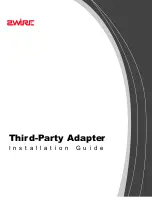
on at the time of the error condition, and then resumes copying. Because it keeps track of where
it was in the COPYAUDIT operation, RDFCOM does not have to recopy the previously copied
image files.
RDFCOM abends if it encounters network problems while searching the remote image trails for
missing audit records. If that happens, RDFCOM logs a message to the EMS event log, but not
to the home terminal.
If RDFCOM encounters network problems during any other phase of COPYAUDIT execution,
it does not abend. Instead, it logs a message to the home terminal and aborts the COPYAUDIT
command.
Example
Assume you have established two RDF configurations to provide triple contingency protection
(\A to \B and \A to \C) and that the RDF control subvolume of the \A to \B configuration is
A1 and the RDF control subvolume of the \A to \C configuration is A2.
Assume further that, after failure of the primary system (\A), you do a takeover on both \B and
\C and determine that \B was further ahead in its RDF processing.
To copy the missing audit records from \B to \C, issue the following command on \C:
]COPYAUDIT , REMOTESYS \B, REMOTECONTROLSUBVOL A1
DELETE
The DELETE command deletes the entire configuration record for the specified secondary image
trail, updater process, or trigger from the RDF configuration file.
DELETE {IMAGETRAIL $volume} [ATINDEX audittrail-index-number]
{[VOLUME] $volume
}
{$volume
}
{TRIGGER type }
IMAGETRAIL $
volume
deletes a secondary image trail from the configuration, implicitly identifying that trail by the
name of the volume on the backup system where it is stored.
[ATINDEX
audittrail-index-number
]
specifies the audit trail associated with the trail or process you want to delete. 0 designates
the MAT; 1 through 15 designate auxiliary audit trails AUX01 through AUX15. If you omit
this parameter, RDFCOM assumes the specified trail or process is associated with the MAT.
[VOLUME] $
volume
deletes an updater process, implicitly identifying the updater process by the name of the
volume on the primary system for which this process is responsible.
TRIGGER type
where type is REVERSE or TAKEOVER. This command parameter deletes a trigger that has
already been added to the RDF configuration.
Where Issued
These commands can be issued only at the primary system, except deleting the TAKOEVER
trigger, which can be issued on either the primary or backup system. If issued on the backup
system, the primary system cannot be accessible.
RDFCOM Commands
199
Содержание NonStop RDF
Страница 68: ...68 ...
Страница 186: ...186 ...
Страница 260: ...260 ...
Страница 278: ...278 ...
Страница 284: ...284 ...
Страница 290: ...290 ...
Страница 308: ...308 ...
Страница 322: ...322 ...
Страница 336: ...336 ...
Страница 348: ...348 ...
Страница 464: ...464 ...
Страница 478: ......
















































